October 11, 2012
by Carole Zangari -
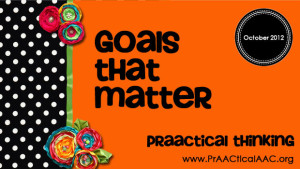
Like some of you, we often get asked “The Question.” People sometimes ask us to give them a recommendation about what AAC device or app is best for a particular individual. When the question comes from a parent or therapist whom we don’t know, it’s understandable. But when it is from a clinician we’ve taught, (who should know better), it’s a bit baffling. Obviously, we’d never make that kind of recommendation without having done an evaluation, or at least reviewing someone else’s assessment. We dread “The Question.” On the other hand, there are a lot of things that we wish people would ask that relate to how to help the communicator develop strong skills. This post relates to to one of those type of questions. “What should I work on?” “What kinds of AAC goals should we write?” We like those kinds of questions and our answers generally have one... [Read More...]
Filed under: PrAACtical Thinking
Tagged With: collaboration, goal bank, goal setting, goals, objectives
October 10, 2012
by Carole Zangari -
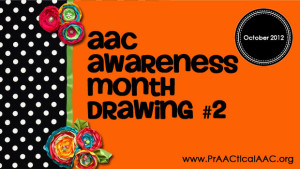
We’re bAACk with another giveaway to celebrate AAC Awareness Month, made possible by the very generous people at the organizations listed below: Ablenet, Inc Abilipad Alexicom BeeVisual Dynavox/Mayer Johnson Gail Van Tatenhove, PA Hump Software iClick iTalk MarbleSoft News-2-You Patient Provider Communication Paul H. Brookes Publishing Company RJ Cooper Safe N Sound Mobile Say It with Symbols Silver Lining Multimedia SpeechPathology.com TapSpeak TherapyBox/TBoxApps Verbally How Does It Work? We use Rafflecopter to administer the giveaways. All entries made through there will be counted toward our drawings. We’re holding three additional drawings this month, and will pick winners on October 17, 24, and 31. Prizes are randomly assigned to each winner. We’ll send an email to each one letting them know what they’ve one. The winners will have 5 days to respond to our email. You’ll need to be a good sport to play along because we’re not going to get... [Read More...]
Filed under: PrAACtical Thinking
Tagged With: AAC Awareness Month, celebration, Giveaway
October 10, 2012
by Carole Zangari -
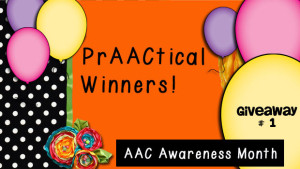
A full year of online CEUs AAC Notecards AAC Eval Genie App Practicing Unity Patterns App Set of PODD CDs Pillow Pet and Storybook 6 different RJ Cooper Apps 15 Codes for Alexicomm Apps We are so thrilled to be able to announce the first set of winners for our AAC Awareness Month Giveaway! This morning we used Rafflecopter to draw 12 names for prizes from Alexicom, Hump Software, RJ Cooper, Dynavox/Mayer Johnson, TapSpeak, Say It with Symbols, SpeechPathology[dot]com, and some from us. Congratulations to Karen McKenzie (#173), Susan Enders Fronek (#140), Leanne Talley Pool (# 65), Mary Behl (#195), Tea Moore (#88), Rebecca Kasdon (#27), Carly (#208), Kristy Davies (#491), Christina Frenzel (#36), Cassandra Stafford (#684), Juliana Escobar (#652), and Angela Bancker Larios (#710). We will be contacting you by email with the particulars later today. Winners, please take a moment to thank your prize donors. We’ll be posting... [Read More...]
Filed under: PrAACtical Thinking
Tagged With: AAC Awareness Month, celebration, Giveaway
October 9, 2012
by Carole Zangari -
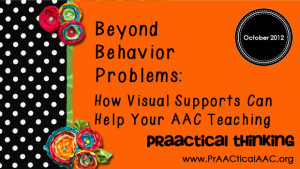
Visual supports are not just for people with behavioral challenges. In this post, we share some ideas of using visual schedules and other supports to enhance comprehension and language learning. Let’s look put this into a clinical context. Marvin is a high school student with intellectual disabilities and cerebral palsy who is learning to use a high tech SGD. He is a personable young man who engages easily and comes to each session with a ‘ready to learn’ mindset. Most of Marvin’s goals revolve on learning to build sentences using core words. Although he has very limited literacy skills, he really, really wants to learn word prediction. This presented a bit of a dilemma, as I typically don’t begin to teach word prediction until spelling skills are approaching the third grade level. Marvin has some terrific splinter skills but his overall spelling skills are probably around the mid-first grade level.... [Read More...]
Filed under: PrAACtical Thinking
Tagged With: intervention, visual supports
October 8, 2012
by Robin Parker -
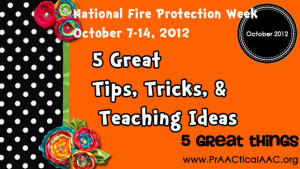
It is National Fire Protection Week October 7-13, 2012. Check Out These 5 Great Tips, Tricks, and Teaching Ideas: Sensory Breaks & Learning Activities Firefighters are being Educated in Auburn On-Line Fire Safety Games for Kids How To Teach and Present Information, Lesson Plans, and Visual Supports for children and adults with Intellectual Disabilities For Teachers and SLPS
Filed under: PrAACtical Thinking
Tagged With: AAC Strategies, Fire Safety, resources, teachers, visual supports
October 8, 2012
by Carole Zangari -
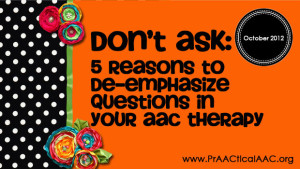
Questions are more like assessment than they are like instruction. Don’t believe us? Look at the questions these therapists posed and see if you didn’t feel like you were being quizzed. What’s your name? Where do you live? Do you know your address? How old are you? When’s your birthday? What school do you go to? What’s your teacher’s name? What’s that called? What do we do with that? Can you tell me more about it? Just to be clear, we think data-based decision-making always plays an important role in good therapy. However, assessment is assessment. Assessment helps us figure out what to teach and how to teach it. But it should look and sound very different than instruction. So when the SLP tells us she is going to teach a new skill by asking a question, we start to tense up. Here’s why we’re de-emphasizing questions in our AAC... [Read More...]
Filed under: PrAACtical Thinking
Tagged With: implementation ideas, intervention, language facilitation
October 7, 2012
by Robin Parker -

PRACTICE FIRE SAFETY- watch what you heat. It’s Fire Prevention Week 2012– October 7-October 15, 2012. There are many Fire Prevention Week campaign resources available through the National Fire Protection Association (NFPA). Additionally, we learned that the National Fire Protection Association (NFPA) has incredible safety information for EVERYONE, All the time. In exploring NFPA’s website, we saw the dedication in protecting ALL children and adults from the many dangers of fire. The Safety Signals Project is another great fire prevention resource funded by Autism Speaks. We are not super worriers by nature, but thought it is would be great time to update some our fire safety supports. National Fire Prevention Association Fire Safety- Specialized Fire Drill Social Narrative Being Prepared-Autism– (Webinar) Fire Safety-Limited Hearing (great information) Fire Safety- Older Adults– (we love the posters) Safety Fact Sheets- Multiple Languages NFPA E-Newsletter– (love the focus on quality of life for people with disabilities) + lots more The Safe... [Read More...]
Filed under: PrAACtical Thinking
Tagged With: ASD, Firs Safety, safety, Social Story
October 5, 2012
by Robin Parker -

We are incredulous! In a GREAT way, an AWESOME way, an EPIC way. The generosity of the AAC community has honestly made us speechless for a moment. Then we quickly had a lot to say about AAC Awareness Month and the PrAACtical Celebration. So ENTER THE GIVEAWAY BECAUSE: The GIVEAWAYS are awesome! You can learn about a lot of new resources! You can get AAC Awareness ideas. You can help promote AAC Awareness Month! It’s fun to try and win! There are a lot of giveaways! You can learn about cool companies to ‘like’ on facebook. You or someone you know may be surprised. AAC Awareness is important! The GIVEAWAYS are awesome! Ablenet, Inc Abilipad Alexicom BeeVisual Dynavox/Mayer Johnson Gail Van Tatenhove, PA Hump Software iClick iTalk MarbleSoft News-2-You Patient Provider Communication Paul H. Brookes Publishing Company RJ Cooper Say It with Symbols Silver Lining Multimedia SpeechPathology.com TapSpeak... [Read More...]
Filed under: PrAACtical Thinking
Tagged With: AAC Awareness Month, Apps, GiveAways
October 4, 2012
by Carole Zangari -
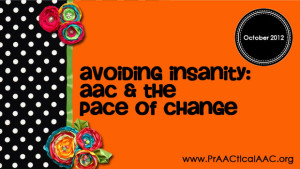
Although the field of AAC emerged only in the last few decades, the notion of communicating in alternative ways is centuries old. In classical times, the use of manual communication by deaf individuals was referred to by Plato and documented in Europe during the Middle Ages. In North America, American Indian Hand Talk evolved over generations to allow cross-cultural communication between speakers of diverse languages. As a clinical/educational field, AAC has been described as evolving through a “bottom-up” mechanism. Individuals with congenital conditions that prevented the development of intelligible speech invented their own communication systems long before teachers, therapists, and clinicians formalized instruction in alternative modes of expression. AAC users growing up in the forties and fifties tell of communicating through grunts, vocalizations, “air writing,” and eye movements, which, though effective in some contexts, were maddening in their limitations. Individuals who were fortunate enough to have access to habilitative and... [Read More...]
Filed under: PrAACtical Thinking
Tagged With: advocacy, change, historical perspective, ideas
October 3, 2012
by Robin Parker -
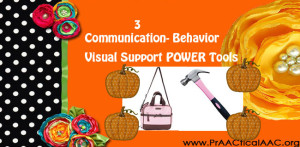
Behavior challenges tend to be a major concern of speech-language pathologists, parents, and educators alike. It is the area that is often most nerve wracking for many professionals and families. But once you get a set of strategies that help you have a plan, most challenging behaviors can be reduced. We like to think of challenging behaviors as opportunities 1: for the learner to practice understanding or expression of communication and language and 2: for facilitators/educators to use behavior strategies or learn new ones. So in order to be best prepared for challenging behaviors, start a Communication-Behavior Strategy Tool Kit. Here some powerful tools that will help ALL learners. 3 Power Tools for Communication & Behavior Choice Boards- helps give a learner power but under our guidelines and boundaries. With choice boards, a student learns more communication while having less power struggles/behavior challenges. Opportunity to teach choice making, expression... [Read More...]
Filed under: PrAACtical Thinking
Tagged With: AAC Strategies, Challenging Behavior, choice boards, first-then board, signs, visual supports









